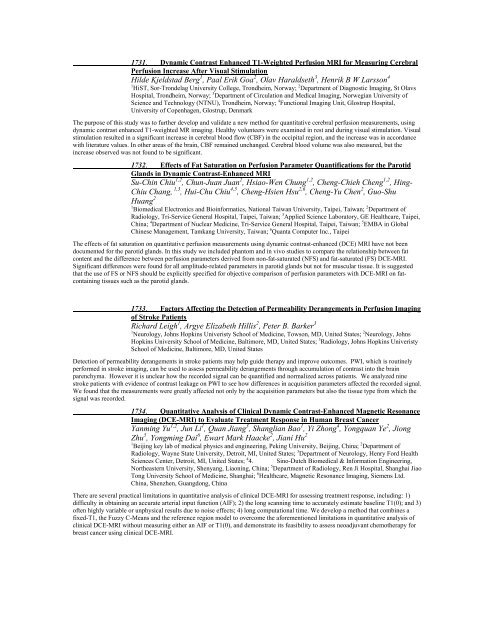Traditional Posters: Diffusion & Perfusion - ismrm
Traditional Posters: Diffusion & Perfusion - ismrm
Traditional Posters: Diffusion & Perfusion - ismrm
Create successful ePaper yourself
Turn your PDF publications into a flip-book with our unique Google optimized e-Paper software.
1731. Dynamic Contrast Enhanced T1-Weighted <strong>Perfusion</strong> MRI for Measuring Cerebral<br />
<strong>Perfusion</strong> Increase After Visual Stimulation<br />
Hilde Kjeldstad Berg 1 , Paal Erik Goa 2 , Olav Haraldseth 3 , Henrik B W Larsson 4<br />
1 HiST, Sor-Trondelag University College, Trondheim, Norway; 2 Department of Diagnostic Imaging, St Olavs<br />
Hospital, Trondheim, Norway; 3 Department of Circulation and Medical Imaging, Norwegian University of<br />
Science and Technology (NTNU), Trondheim, Norway; 4 Functional Imaging Unit, Glostrup Hospital,<br />
University of Copenhagen, Glostrup, Denmark<br />
The purpose of this study was to further develop and validate a new method for quantitative cerebral perfusion measurements, using<br />
dynamic contrast enhanced T1-weighted MR imaging. Healthy volunteers were examined in rest and during visual stimulation. Visual<br />
stimulation resulted in a significant increase in cerebral blood flow (CBF) in the occipital region, and the increase was in accordance<br />
with literature values. In other areas of the brain, CBF remained unchanged. Cerebral blood volume was also measured, but the<br />
increase observed was not found to be significant.<br />
1732. Effects of Fat Saturation on <strong>Perfusion</strong> Parameter Quantifications for the Parotid<br />
Glands in Dynamic Contrast-Enhanced MRI<br />
Su-Chin Chiu 1,2 , Chun-Juan Juan 2 , Hsiao-Wen Chung 1,2 , Cheng-Chieh Cheng 1,2 , Hing-<br />
Chiu Chang, 1,3 , Hui-Chu Chiu 4,5 , Cheng-Hsien Hsu 2,6 , Cheng-Yu Chen 2 , Guo-Shu<br />
Huang 2<br />
1 Biomedical Electronics and Bioinformatics, National Taiwan University, Taipei, Taiwan; 2 Department of<br />
Radiology, Tri-Service General Hospital, Taipei, Taiwan; 3 Applied Science Laboratory, GE Healthcare, Taipei,<br />
China; 4 Department of Nuclear Medicine, Tri-Service General Hospital, Taipei, Taiwan; 5 EMBA in Global<br />
Chinese Management, Tamkang University, Taiwan; 6 Quanta Computer Inc., Taipei<br />
The effects of fat saturation on quantitative perfusion measurements using dynamic contrast-enhanced (DCE) MRI have not been<br />
documented for the parotid glands. In this study we included phantom and in vivo studies to compare the relationship between fat<br />
content and the difference between perfusion parameters derived from non-fat-saturated (NFS) and fat-saturated (FS) DCE-MRI.<br />
Significant differences were found for all amplitude-related parameters in parotid glands but not for muscular tissue. It is suggested<br />
that the use of FS or NFS should be explicitly specified for objective comparison of perfusion parameters with DCE-MRI on fatcontaining<br />
tissues such as the parotid glands.<br />
1733. Factors Affecting the Detection of Permeability Derangements in <strong>Perfusion</strong> Imaging<br />
of Stroke Patients<br />
Richard Leigh 1 , Argye Elizabeth Hillis 2 , Peter B. Barker 3<br />
1 Neurology, Johns Hopkins Univeristy School of Medicine, Towson, MD, United States; 2 Neurology, Johns<br />
Hopkins University School of Medicine, Baltimore, MD, United States; 3 Radiology, Johns Hopkins Univeristy<br />
School of Medicine, Baltimore, MD, United States<br />
Detection of permeability derangements in stroke patients may help guide therapy and improve outcomes. PWI, which is routinely<br />
performed in stroke imaging, can be used to assess permeability derangements through accumulation of contrast into the brain<br />
parenchyma. However it is unclear how the recorded signal can be quantified and normalized across patients. We analyzed nine<br />
stroke patients with evidence of contrast leakage on PWI to see how differences in acquisition parameters affected the recorded signal.<br />
We found that the measurements were greatly affected not only by the acquisition parameters but also the tissue type from which the<br />
signal was recorded.<br />
1734. Quantitative Analysis of Clinical Dynamic Contrast-Enhanced Magnetic Resonance<br />
Imaging (DCE-MRI) to Evaluate Treatment Response in Human Breast Cancer<br />
Yanming Yu 1,2 , Jun Li 1 , Quan Jiang 3 , Shanglian Bao 1 , Yi Zhong 4 , Yongquan Ye 2 , Jiong<br />
Zhu 5 , Yongming Dai 6 , Ewart Mark Haacke 2 , Jiani Hu 2<br />
1 Beijing key lab of medical physics and engineering, Peking University, Beijing, China; 2 Department of<br />
Radiology, Wayne State University, Detroit, MI, United States; 3 Department of Neurology, Henry Ford Health<br />
Sciences Center, Detroit, MI, United States; 4 4. Sino-Dutch Biomedical & Information Engineering,<br />
Northeastern University, Shenyang, Liaoning, China; 5 Department of Radiology, Ren Ji Hospital, Shanghai Jiao<br />
Tong University School of Medicine, Shanghai; 6 Healthcare, Magnetic Resonance Imaging, Siemens Ltd.<br />
China, Shenzhen, Guangdong, China<br />
There are several practical limitations in quantitative analysis of clinical DCE-MRI for assessing treatment response, including: 1)<br />
difficulty in obtaining an accurate arterial input function (AIF); 2) the long scanning time to accurately estimate baseline T1(0); and 3)<br />
often highly variable or unphysical results due to noise effects; 4) long computational time. We develop a method that combines a<br />
fixed-T1, the Fuzzy C-Means and the reference region model to overcome the aforementioned limitations in quantitative analysis of<br />
clinical DCE-MRI without measuring either an AIF or T1(0), and demonstrate its feasibility to assess neoadjuvant chemotherapy for<br />
breast cancer using clinical DCE-MRI.















